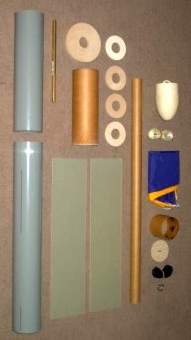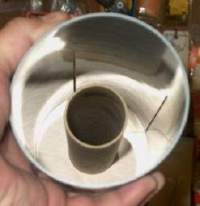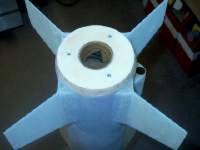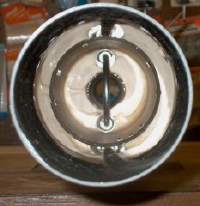Scratch AGM-84 Harpoon Original Design / Scratch Built
Scratch - AGM-84 Harpoon {Scratch}
Contributed by Carl Tulanko
| Manufacturer: | Scratch |
 Brief:
Brief:
For a long time now, my favorite rockets have been military missiles. I have
built many in the past and wanted to build a HPR version of the Harpoon AGM-84.
I decided to scratch build, since there were no kits to fit the bill, and
designed a 4" 33% Scale Harpoon AGM-84. The rocket has a 38mm motor mount,
54" PML parachute, Nomex
®
cloth, Kevlar
®
for shock cord and a detailed scale set of decals.
The body tube is made of PML 4" Quantum tubing, which I had custom slotted and cut at the factory. They did their usual great job, and they followed my cutting/slotting instructions to the tee! Hats off to the guys at PML.
This will be the first to be built in a series of 4" models I have designed and are on the building board. I did check the WPAFB Museum website and they have one of every missile I have interest in on site, with the exception of this one. For some reason, it couldn't be that this is primarily a Navy missile, I had a hard time finding pics for it so I could do scale decals. Some good pics were found and I was able to create some decals that are very close to scale.
Construction:

Construction began by cutting the 38mm motor mount tube to 23.75". Then I measured and glued the first centering ring, which is the lower of two rings for the center fins. Both sets of fins are sandwiched between centering rings. Next, I cut out the fins from the RockSim pattern I printed out from the design. Using a Dremel, asbestos cutting wheel, and a vacuum to pull in the dust while I cut, all four upper fins and four lower fins were cut with ease from the G10 sheeting. They were final sanded on my table sander and now fit the slots well. After cutting my own G10 fins, I highly recommend this to anyone who wishes to scratch build; it will save you a fortune over pre-cut fins and are very easy and fast to make.
The four inch coupler was cut to a length of 7" and edges were sanded. Finally, I measured the 1/2" thick by six inch centering ring, which will extend past the rear of the body tube as a boattail. It was reduced to 4" in diameter, so it would fit flush with the outside of the body tube.
 A centering ring
was mounted to the motor mount tube and it was installed in the body tube after
roughing it up with sandpaper. This CR sits just below the slots for the center
fins. A second CR was installed just above the lower fin slots. Fin edges were
rounded and surfaces were roughed up and the lower fins were glued in place to
the motor mount and upper CR. Also, the lower fins were glassed from the motor
mount, up the inside of each fin and across the inside of the body tube area.
In addition, the lower centering ring was installed flush with the body tube
and against the bottom of the lower fins. Finally, the lower transition was
sanded to angle the bottom edge for the "transition" look.
A centering ring
was mounted to the motor mount tube and it was installed in the body tube after
roughing it up with sandpaper. This CR sits just below the slots for the center
fins. A second CR was installed just above the lower fin slots. Fin edges were
rounded and surfaces were roughed up and the lower fins were glued in place to
the motor mount and upper CR. Also, the lower fins were glassed from the motor
mount, up the inside of each fin and across the inside of the body tube area.
In addition, the lower centering ring was installed flush with the body tube
and against the bottom of the lower fins. Finally, the lower transition was
sanded to angle the bottom edge for the "transition" look.
 I worked on the
ply 1/2" thick tail transition piece. 3 holes were drilled through it to
accept the 8/32 sized bolts for the PML motor retainer. I used a 1/2"
drill bit to open a recess in the top side of the transition, then carve it out
using a dremel and small sanding tube so the blind nuts would sit recessed
inside this "well". This was necessary so the piece could be glued
flush to the bottom CR on the model. Next, I placed some glue inside the recess
and installed the three blind nuts, then tested for a flush fit. Finally, the
blind nut threads were filled with wax, then the excess wax was shaved flush
and I epoxied the transition to the bottom of the rocket and motor mount. Upper
fins were next; each canard fin was glued to the motor mount and lower
centering ring. I also took the final centering ring, the one that would fit on
top of the center fins and drilled two holes, then mounted the Stainless Steel
3" wide U-Bolt for the shock cord.
I worked on the
ply 1/2" thick tail transition piece. 3 holes were drilled through it to
accept the 8/32 sized bolts for the PML motor retainer. I used a 1/2"
drill bit to open a recess in the top side of the transition, then carve it out
using a dremel and small sanding tube so the blind nuts would sit recessed
inside this "well". This was necessary so the piece could be glued
flush to the bottom CR on the model. Next, I placed some glue inside the recess
and installed the three blind nuts, then tested for a flush fit. Finally, the
blind nut threads were filled with wax, then the excess wax was shaved flush
and I epoxied the transition to the bottom of the rocket and motor mount. Upper
fins were next; each canard fin was glued to the motor mount and lower
centering ring. I also took the final centering ring, the one that would fit on
top of the center fins and drilled two holes, then mounted the Stainless Steel
3" wide U-Bolt for the shock cord.
 Next, I glassed
each canard fin inside to the motor mount and inside body tube, then glued in
the last centering ring with the U-Bolt as a top cap to the center fins. The
coupler was installed next, followed by the upper section of body tube. I ran
masking tape around the seam to help keep both upper an lower body tubes in
alignment with each other until the glue set. I have seen where a coupler has
some play and can leave the joint a bit "out of round", which leaves
a little overlap between the tubes. Using several wraps of masking tape kept it
in alignment and the tape easily pulled off once the glue has set. The coupler
adds strength to the centering ring since it is holding the ring down atop the
center fins. This method was used to insure it had a solid anchor since it has
to handle the stress of deployment.
Next, I glassed
each canard fin inside to the motor mount and inside body tube, then glued in
the last centering ring with the U-Bolt as a top cap to the center fins. The
coupler was installed next, followed by the upper section of body tube. I ran
masking tape around the seam to help keep both upper an lower body tubes in
alignment with each other until the glue set. I have seen where a coupler has
some play and can leave the joint a bit "out of round", which leaves
a little overlap between the tubes. Using several wraps of masking tape kept it
in alignment and the tape easily pulled off once the glue has set. The coupler
adds strength to the centering ring since it is holding the ring down atop the
center fins. This method was used to insure it had a solid anchor since it has
to handle the stress of deployment.
Once everything had dried, I started glassing the lower fins. At this time, one of four sides is glassed. While the epoxy was still curing for the cloth, I cut the lower 1/2" launch lug to a length of 2 1/2", then epoxied it between the lower fins, 1" from the body tube bottom. Next, I finished fiberglassing the fins, then added fillets to the upper canard fins and mounted the upper launch lug.
The upper fillet sanding was completed. In addition, the seam was sanded smooth and lower fillets were sanded, but the cloth edge still needs blended to the body tube. Also, the bottom of the boattail plywood was glazed with epoxy.
Some work was done on the Nosecone; if you all have never had the pleasure of using the RGM Nosecones, you are really missing out! The quality is fantastic with a SEAMLESS design, yes, I said seamless. It was like a rocketeers dream come true! The nosecone is made from resin and cloth and is yellow in color, similar to the resin model airplane and boat kits you can buy. The quality is excellent, with a good fit at the base, a molded-in U-Bolt and ultra smooth finish, right out of the box. They are to date the only "round" Nosecone I could find in the 4" version. As a final FYI, Ross at Magnum told me that the gentleman at RGM lays up all these cones one at a time, by hand! With a price of $29.95, they are about $10 more than a plastic ogive nosecone, but you get what you pay for and it's worth it!
The nosecone was lightly sanded and washed to remove any release agents, then one coat of primer was applied, which came out nice. No problems were found with the primer sticking to this resin Nosecone.
The glassing in the lower fin area was sanded and blended using a dremel power sander, then touched up by hand with 100 grit sandpaper. Plugs were inserted into the lugs so they would not get painted inside, then the holes for the motor retainer were re-drilled out and blind nuts were tapped with an 8/32 tap to remove the wax used to seal the threads from epoxy.
Finishing:
 Three coats of
white Krylon primer were applied to the body, followed by two coats of gray
Krylon primer. Pinholes were filled next, then sanded with 220 grit sandpaper.
Two more coats of gray primer were applied, followed by 3 coats of white
primer. I am letting the body tube dry overnight and will wetsand it tomorrow,
then apply more primer if necessary and the colors. Finally, the nosecone was
given about 6 coats of primer, then wetsanded with 320 grit wet/dry sandpaper;
3 more coats of white primer were applied to the nosecone and left to dry
overnight.
Three coats of
white Krylon primer were applied to the body, followed by two coats of gray
Krylon primer. Pinholes were filled next, then sanded with 220 grit sandpaper.
Two more coats of gray primer were applied, followed by 3 coats of white
primer. I am letting the body tube dry overnight and will wetsand it tomorrow,
then apply more primer if necessary and the colors. Finally, the nosecone was
given about 6 coats of primer, then wetsanded with 320 grit wet/dry sandpaper;
3 more coats of white primer were applied to the nosecone and left to dry
overnight.
The model was wetsanded with 400 grit wet/dry paper, then 600 grit. I painted the Nosecone first, with 4 coats of Krylon Glossy White spray paint. Next, the body tube was painted, also with four coats. They are both dry, but I am letting it set overnight before painting the stripes. In the interum, I am working on some scale decals for the Harpoon, but need pictures...I don't have any good pictures of the lettering for different sections.
The Harpoon was weighed at our first HPR launch ever for our Cincinnati NAR club. I almost fell over when I saw, but knew it was going to be heavy, as I added most of the ballast in birdshot that Ken Parker gave me when I was in NC this past summer. It weighed in at 6lbs 7.8oz without motor!!!!!
I almost died...going to have to re-do all my sims to see if it can handle an I211 because, even though she isn't painted, she was going to fly at our HPR Launch, which is a two day event. It will be like flying a heavy torpedo, which is what it represents anyway, so what the heck.
Flight:
I had two launches using an I211W for the Harpoon's maiden flights. The first
flight was perfect; awesome power and came off the pad stable, lifted well and
deployed right at apogee. The rocket landed safely and the 54" PML
parachute I used worked well and was unmarred due to the use of a Kevlar®
cloth. However, the second launch had an early ejection.
Recovery:
The nosecone tore off the cord and plummeted to the earth, yet was recovered
after digging it out, with only scratches. The rocket landed right on top of a
tree, about 40 feet up. I spent 7 days trying to retrieve it before it came out
of the tree.
The rocket suffered a minor zipper in the upper body tube, which was easily repaired. I used Kevlar ® shock cord for the model and it came out with no marks at all.
Summary:
The tube was replaced and I applied all decals for the Harpoon. It really looks
good now and will fly again soon. Anyone interested in military missiles should
consider building one of these. The file has been uploaded to EMRR and it's a
great flier and real looker. Moreover, you can have a set of decal files with
all the work done simply by sending me an email or visiting Jim Ball's Scale
Data website, which should have my decals uploaded soon. Since the design and
decals are complete and it's a good flier, most of your work is already done,
so take the leap and impress the crowd with this AGM-84 Harpoon.
Sponsored Ads
 |
 |











